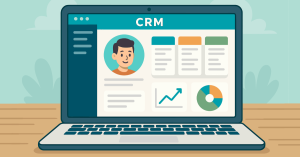Hey, CRM marketers, sending leads from your marketing automation to your CRM environment isn’t a one-time event. Those leads still need nurturing—both to keep current customers happy and to encourage those early hand-raisers to fully convert into actual hot leads. The best way to this? Ensure your CRM system is funneling opportunity to your marketing automation platform (like the emfluence Marketing Platform, say) with the data it needs to generate the most effective follow-up campaigns.
In the world of email automation, this data passage is referred to as “trigger” marketing. That means the email campaign is powered by a trigger action—like a status change, a field modification/addition/deletion, or a logged activity. By setting up the right kind of email campaign “triggers,” you’ll get a lot more out of your CRM and marketing automation platform integration.
Let’s take a close look at exactly what CRM triggers are and how best to implement them.
The Ultimate Strategy Guide to Microsoft Dynamics and Marketing Automation
Learn how to integrate dynamics with your email, social, & more
Key CRM Triggers for Automated Email Campaigns
Let’s start with types of triggers. On the CRM side, when a Lead or existing Contact has an associated Activity that is logged in your CRM, triggers should be set to initiate an automated response from your marketing automation platform. Typically, the Activity—like a completed Appointment or a Phone Call or a Status change (like a closed opportunity or a lead gets qualified)—triggers a workflow that adds the Lead or the Contact to a Marketing List. That Marketing List is then mapped to a list in your marketing automation platform, and a triggered email campaign is born.
A good marketing list for your triggered email campaign starts with understanding how your data maps between the two systems. Think through what data fields you need to connect, especially if you’re mapping custom fields in CRM—not every marketing automation platform allows you to map beyond the standard fields, like first name, company, etc. It’s also important to think through how you’ll get the data in CRM that you’ll need to power those triggered campaigns, so be sure to have a conversation with your sales team and take a close look at APIs from external data sources you may have available.
The following is a list of important triggers that you would be wise to leverage as workflow/Marketing List triggers:
- Product purchases (won Opportunities)
- Process incompletion (like a stalled Opportunity)
- Engagement with a customer service representative
- Important dates (Opportunity lost dates, contract end dates, or last contact dates)
- Activity completions (appointments, phone calls, etc.)
Building Those CRM-Based Campaigns
Automated, or “triggered” email campaigns are powered by data, and since they tend to begin with a status change, your data AND your message should reflect that change. Here are a few campaigns you might consider powering out of your CRM and marketing automation platform:
- Lead Nurtures—Sales team can’t reach that inbound lead? Set up a 365-day nurture that’s powered by your sales team adding stale leads to a list in CRM, and design the email to look like a check in from your sales person’s inbox.
- Onboarding Campaigns—Use Won Opportunity status changes to launch a new client onboarding campaign. Tell your new client what to expect in the first few weeks, and follow that with training links, survey check ins, and eventually ask for reviews and/or referrals.
- Client “scrub” lists—there’s no need to nurture your existing clients, so use your CRM system to create a “scrub” list for your nurture campaigns. If you run nurtures post-downloads, drop your client list between the download email and the rest of the nurture so they aren’t asked to sign up for your service (that they already have).
- Win Back Campaigns—Lost Opportunities are still opportunities. Set up a nurture that launches six months before the service should end with the competitor you lost them to. They might be interested in a change!
Avoiding the Pitfalls
Integrating your CRM with your marketing automation platform is great, but there are a few pitfalls to watch out for:
- Using exclusion groups to make sure contacts or leads haven’t wandered into the wrong data query
- Get your sales team on board—help them understand what sorts of campaigns are powered by what data fields so that they can help you gather data
- Use preview tools to check your personalizations
- Monitor email performance and cadence—if you’re running a multi-email campaign, for example, monitor when or if people tend to opt out and consider shortening your cadence or lengthening your wait steps.
Once you’ve achieved the right balance, you’ll quickly be reaping the rewards that come with maximizing your CRM/marketing automation platform integration.
Want to learn more about CRM and marketing automation strategy? Let’s chat!
Ready to get started?


